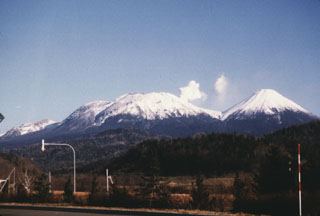Report on Akan (Japan) — September 1992
Bulletin of the Global Volcanism Network, vol. 17, no. 9 (September 1992)
Managing Editor: Lindsay McClelland.
Akan (Japan) Summit-area seismic swarm
Please cite this report as:
Global Volcanism Program, 1992. Report on Akan (Japan) (McClelland, L., ed.). Bulletin of the Global Volcanism Network, 17:9. Smithsonian Institution. https://doi.org/10.5479/si.GVP.BGVN199209-285070
Akan
Japan
43.384°N, 144.013°E; summit elev. 1499 m
All times are local (unless otherwise noted)
Earthquake activity began increasing on 22 September, peaking on 2 October with 146 recorded events (figure 4), then gradually decreased to a background of 1/day by 9 October. No shocks were felt. Epicenters were presumed to be at or near the active (Ponmachineshiri) crater. Seismicity at the volcano has been low since March 1991.
 |
Figure 4. Monthly number of earthquakes recorded at Akan, 1973-92. High seismicity occurred in late September after 1.5 years of quiet. Courtesy of JMA. |
Geological Summary. Akan is a 13 x 24 km caldera located immediately SW of Kussharo caldera. The elongated, irregular outline of the caldera rim reflects its incremental formation during major explosive eruptions from the early to mid-Pleistocene. Growth of four post-caldera stratovolcanoes, three at the SW end of the caldera and the other at the NE side, has restricted the size of the caldera lake. Conical Oakandake was frequently active during the Holocene. The 1-km-wide Nakamachineshiri crater of Meakandake was formed during a major pumice-and-scoria eruption about 13,500 years ago. Within the Akan volcanic complex, only the Meakandake group, east of Lake Akan, has been historically active, producing mild phreatic eruptions since the beginning of the 19th century. Meakandake is composed of nine overlapping cones. The main cone of Meakandake proper has a triple crater at its summit. Historical eruptions at Meakandake have consisted of minor phreatic explosions, but four major magmatic eruptions including pyroclastic flows have occurred during the Holocene.
Information Contacts: JMA.

